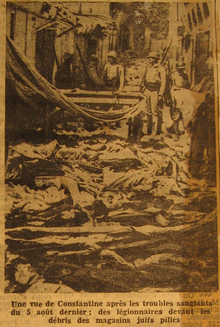1934年君士坦丁騷亂
| 1934年君士坦丁騷亂 | |
|---|---|
 | |
| 位置 | |
| 日期 | 1934年8月3日—8月5日 |
| 目標 | 阿爾及利亞的猶太人[1] |
| 類型 | 騷亂[1]、縱火[2]、搶劫[3][4] |
| 死亡 | 25名猶太人、3名穆斯林[4][5] |
| 受傷 | 大約200人[4][5] |
| 動機 | 反猶太主義[6] |
1934年君士坦丁騷亂是法屬阿爾及利亞君士坦丁市爆發的一場針對當地猶太人的騷亂[1][7][8],騷亂根源被認為是法國殖民政府區別對待阿爾及利亞的猶太人和穆斯林[4]。目前尚不清楚騷亂的確切原因,但各種說法認為騷亂是由君士坦丁西迪拉赫達爾清真寺內一名猶太男子與一些穆斯林之間的爭吵引發的[4][9]。據多個消息來源報道,為期三天的騷亂造成25名猶太人和3名穆斯林死亡,多家猶太機構遭到洗劫[4][5]。這起騷亂事件也被描述為一場反猶騷亂[6]。
背景
[編輯]
1934年君士坦丁騷亂的背景可以歸結為法屬阿爾及利亞日益高漲的反猶太主義。緊張局勢的一個根源是1870年10月實施的《克雷米厄法令》,該法令允許阿爾及利亞猶太人獲得法國公民身份。[10][11]對於法國政府來說,這項法令被視為北非「文明使命」的一部分[12]。
法國多個政黨和政治人物都反對這一決定,其中許多原因都源於反猶太主義或更普遍的仇外心理。法國人反對該法令的原因之一是他們認為猶太人更適合從事商業工作,他們擔心法國公民身份會讓更多的猶太人加入法國軍隊。許多右翼、激進的法國民族主義者同意查爾斯·杜布澤的說法,即阿爾及利亞猶太人與西方文明根本不相容。[11][5]前奧蘭行政官兼駐阿爾及利亞特派專員杜布澤指出,阿爾及利亞猶太人的「道德、語言和服飾」使他們成為阿拉伯人,因此有別於法國人[5]。激進的法國民族主義者認為,阿爾及利亞猶太人逐漸在政治上融入並同化法國社會,對「本土」法國社會構成了威脅[5]。
20世紀初,阿爾及利亞的反猶太主義情緒高漲。例如,反猶太主義運動拉丁裔聯盟的領導人朱爾斯·莫勒博士於1925年成為奧蘭市長,並於1928年成為該市的議員。聲稱左翼政治提倡「猶太帝國主義」的加布里埃爾·蘭伯特神父(Abbé Gabriel Lambert)於1934年成為奧蘭市長。奧蘭和君士坦丁的本地報紙《小奧蘭報》和《論壇報》(La Tribune)定期傳播反猶太主義信息。[5]
有證據表明,反猶太主義的法國定居者試圖在阿爾及利亞穆斯林群體中灌輸反猶太主義情緒,並引發君士坦丁的穆斯林和猶太人之間的爭吵[13]。根據當時媒體和警方的報告,未找到證據表明本地穆斯林政客或神職人員在20世紀20年代和30年代公開宣傳了反猶太主義信息[13]。人們還普遍認為是納粹煽動了這場騷亂[6]。
過程
[編輯]
君士坦丁大屠殺的起因尚有爭論。普遍的共識是,衝突的最初起因是1934年8月3日猶太人祖阿夫埃利亞侯·哈利法與穆斯林信徒在西迪拉赫達爾清真寺發生的爭執。穆斯林稱哈利法喝醉了,侮辱了伊斯蘭教。猶太當局的一份報告稱,哈利法沒有喝醉,在與穆斯林發生爭執後,穆斯林詛咒了哈利法的信仰,哈利法也詛咒了穆斯林和他們的信仰。[8][9]法國殖民當局只報道了穆斯林版本的事件,多數學者認為這引發了這場屠殺[14]。也有報道稱,哈利法曾在清真寺的牆上小便,可能引發了騷亂[9]。8月3日晚,在哈利法的公寓發生的暴力示威活動中,一名穆斯林男子腹部中槍[4]。法國政府派出148名士兵和52名警察前往控制該市的騷亂[15]。
8月4日星期六,騷亂仍在繼續,當地領導人、穆斯林和猶太社區代表同警方和軍方代表聚集在一起,商討和平結束暴力的對策。[4][15][3]
8月5日星期日,當地穆斯林政治人物穆罕默德·薩利赫·本德傑魯遭暗殺的謠言四起,暴力事件再度爆發。然而,謠言最終被證實是假的。[4][16]騷亂持續了數小時,並蔓延至君士坦丁附近的城鎮[4]。反對種族主義和反猶太主義國際聯盟(LICRA)君士坦丁分部張貼了阿拉伯語和法語的海報,呼籲和平並結束暴力[17]。
據報道,騷亂最終導致25名猶太人和3名穆斯林死亡,約200人受傷,多家猶太企業和住宅也遭到摧毀或搶劫。[4][5][3]
報道
[編輯]猶太電訊社於1934年8月8日報道:
一位今天成功抵達這座城市的猶太電訊社記者描述了當時的情景:猶太女孩的乳房被割掉,兒童身上有多處刀傷,全家人被鎖在家中被燒死,場面十分淒涼和恐怖。
「世人需要幾天的時間才能真正了解阿拉伯人在猶太人大屠殺期間犯下的全部暴行」,記者在電報中寫道。
「我能想到的唯一可與之相比的就是1929年的巴勒斯坦騷亂。我發現猶太女孩的乳房被割掉,灰鬍子猶太人被刺死,猶太兒童死於多處刀傷,全家都被鎖在家中,被暴徒活活燒死。」
「就像1929年的巴勒斯坦一樣,死傷人數多達數百人,但官方沒有給出確切數字。醫院裡擠滿了猶太受害者,醫院門口圍滿了半瘋的妻子和母親,她們想確定自己的親人是否在死傷者之列,或者是否成功逃脫了屠殺。」[2]
後續
[編輯]騷亂和屠殺之後,有法國媒體因刊登了殘缺屍體的照片而受到批評,被認為煽動了有害的社區氣氛。[18]
8月8日,受害者葬禮期間舉行了紀念儀式。猶太社區領袖和殖民當局代表出席了儀式,穆斯林官員未前往現場。幾天後,君士坦丁穆斯林當局發表了一份聲明,呼籲拒絕暴力,並譴責任何在政治上利用反猶太主義騷亂的企圖。[18]
相關條目
[編輯]參考資料
[編輯]- ^ 1.0 1.1 1.2 Sharon Vance. The Martyrdom of a Moroccan Jewish Saint. BRILL. 2011-05-10: 182. ISBN 978-90-04-20700-4 (英語).
Muslim anti Jewish riots in Constantine in 1934 when 34 Jews were killed
- ^ 2.0 2.1 Algeria Riots Checked. Jewish Telegraphic Agency. 1934-08-08 (英語).
- ^ 3.0 3.1 3.2 Boum, Aomar. Partners against Anti-Semitism: Muslims and Jews respond to Nazism in French North African colonies, 1936–1940. The Journal of North African Studies. 2014, 19 (4): 557. S2CID 144799112. doi:10.1080/13629387.2014.950175 (英語).
- ^ 4.00 4.01 4.02 4.03 4.04 4.05 4.06 4.07 4.08 4.09 4.10 Cole, Joshua. Constantine before the riots of August 1934: civil status, anti-Semitism, and the politics of assimilation in interwar French Algeria. The Journal of North African Studies. 2012, 17 (5): 839–861. S2CID 143595241. doi:10.1080/13629387.2012.723432 (英語).
- ^ 5.0 5.1 5.2 5.3 5.4 5.5 5.6 5.7 McDougall, James. A History of Algeria. Cambridge University Press. 2017: 116–117. ISBN 978-0-521-85164-0 (英語).
- ^ 6.0 6.1 6.2 The Constantine Pogroms. The Sentinel. 1934-08-23 [2024-07-12] (英語).
- ^ Stein, Rebecca. Palestine, Israel, and the Politics of Popular Culture. Duke University Press. 2005: 237. ISBN 0-8223-3504-2 (英語).
- ^ 8.0 8.1 Levy, Richard. Antisemitism: A Historical Encyclopedia of Prejudice and Persecution, Volume 1. ABC-CLIO. 2005-05-24: 139 (英語).
Between August 3 and 5, 1934, Muslim mobs went on a rampage in the Algerian city of Constantine, attacking Jews and Jewish property. In the attack, 25 Jewish men, women, and children were killed, most from having their throats cut or their skulls crushed, and 26 more were injured, according to official statistics. More than 200 Jewish-owned stores were ransacked. The total property damage to homes, businesses, and synagogues was estimated at over 150 million Poincare francs. Some 3,000 people, one-quarter of Constantine's Jewish population, were in need of welfare assistance in the aftermath of the pogrom. During the rampage, anti-Jewish incidents were recorded in the countryside of the Department of Constantine, extending over a 100-kilometer radius. Jews were murdered in Hamma and Mila, and in Ain Beida, Jewish homes and businesses were looted. During much of the rioting, the French police and security forces stood by and did little or nothing to stop the rioters.
- ^ 9.0 9.1 9.2 Allali, Jean-Pierre; Musicant, Haim. Des Hommes Libres: des histoires extraordinaires de l'histoire de la LICRA. Editions Bibliophane. 1987: 22–23 (法語).
- ^ Stein, Sarah Abrevaya. Saharan Jews and the Fate of French Algeria. Chicago, IL: The University of Chicago Press. 2014: xi. ISBN 978-0-226-12374-5 (英語).
- ^ 11.0 11.1 Schreier, Joshua. Arabs of the Jewish Faith: The Civilizing Mission in Colonial Algeria. New Brunswick, NJ: Rutgers University Press. 2010: 8. ISBN 978-0-8135-4794-7 (英語).
- ^ McDougall, James. A History of Algeria. Cambridge University Press. 2017: 115. ISBN 978-0-521-85164-0 (英語).
- ^ 13.0 13.1 Cole, Joshua. Constantine before the riots of August 1934: Civil Status, Anti-Semitism, and the Politics of Assimilation in Interwar French Algeria. The Journal of North African Studies. 2012, 17 (5): 847. S2CID 143595241. doi:10.1080/13629387.2012.723432 (英語).
- ^ Samuel Kalman. The Extreme Right in Interwar France: The Faisceau and the Croix de Feu. Ashgate Publishing. 2008: 210–216 [2024-07-12] (英語).
- ^ 15.0 15.1 Cole, Joshua. Lethal Provocation: The Constantine Murders and the Politics of French Algeria. Cornell University Press. 2019: 123 (英語).
- ^ Cole, Joshua. Lethal Provocation: The Constantine Murders and the Politics of French Algeria. Cornell University Press. 2019: 130–131 (英語).
- ^ Cole, Joshua. Lethal Provocation: The Constantine Murders and the Politics of French Algeria. Cornell University Press. 2019: 126 (英語).
- ^ 18.0 18.1 Joshua Cole. Antisémitisme et situation coloniale pendant l'entre-deux-guerres en Algérie. 20 & 21. Revue d'histoire. 2010 [2024-07-12]. (原始內容存檔於2017-12-23) (法語).
